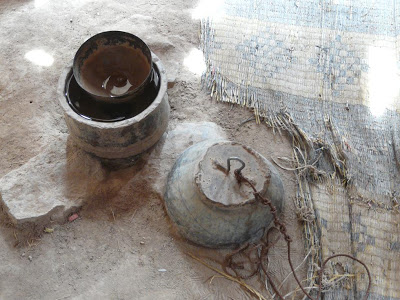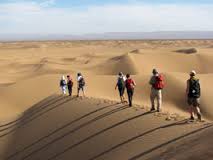

Foum Assaka, tourist interest site attracts already the tourist professionals. This coast of great views and ecological richness is the subject of tourist vocation.
Foum Draâ, isolated site and difficult to accede by track from the national road RN1. It sets out a remarkable views quality with varied fauna. The site has been the subject of a detailed analysis of a future tourist development as part of a study on a tourist area schedule and development which will number 8 000 beds.
In addition of the mouths, the wadi surroundings towards the inside offer a tourist attraction potential a not inconsiderable one which arouses the investors interest from the tourist sector. It is the case, notably, of a french property developer who has built a hotel unity at Fort Boujrif (rural commune of Targawassay- commune of Guelmim) who knows an important success by attractring more than 400 tourists from different nationalities by month. Same thing for the Ksar of Tafnidilt located along the Draâ wadi and which knows the same success, the station Abaynou, eco Musée of Tighmerte. 2 other implementations Dar Infiane at Tata and the Akka Nait Sidi VIP bivouac (rural commune of Tissint) are to be mentioned for the same original concept and for its success.
Plage Blanche, this unity would be developed at 50 kms from the south of Ifni and at 60 kms from the south-east of Guelmim. Its particularity will be of being the first eco tourist seaside resort with 30 000 beds capacity.
Hotel units ( 5* and 4* hotels and villages for tourist holidays) for about 5 300 beds capacity. An 18 holes golf, an commercial and craft center, a SPA and leisure implementations.
Residential unities for a total 10 500 beds capacity, about 2 200 flats and villas. The Fades group estimated that the works would last 8 years, the first hotel is planned to open its doors on 2012.
The National Park “Bas Draâ” is one of the most important national park, with a desert landscape and low human density. It constitutes an ideal biotope for a diversified and rich fauna nearly dying out (gazelles, dorcas, cuffed wild sheeps, carnivores including the striped hyena, jackal, red fox, fennec, porcupine, as well as birds as bustard, lancer falcon, the royal eagle, adding on reptiles). It is a biodiversity of high interest potential
Chbika wadi, Foum Chbika site, at about 30 kms from the south of El Ouatia The convention on the installation of the tourist station «oued chbika «in tan tan,entrusted to the Egyptian group»orascom»has required an amount of 6 billions dirhams.the project which will contribute to the creation of 2.500 jobs,consists of the realization of hoteliary units with a capacity of 5.000beds,of residences(1.851units),ludic and sporting infrastructures(centre of congress,museum,and a sport center)
The cave engravings from the Tata district to the Es-Smara district, the first discoveries of cave art date back the 19th century. At present, we number more than 300 sites spread over the whole territory.This sites, in which prehistoric men used to engrave, are often on the open-air and in general, located on the wadis side.
As per its geographical location, they can be classified into three concentrations : the Haut-Atlas plateau, along the Draâ valley and next to the dried-up wadis of the saharan districts. The cultural heritage of Morocco is represented through all of these periods from prehistory (from ancient Palaeolithic to Neolithic) to history, going by protohistory.
Some sites are the subject of active archeological researches. It allows us to distinguish the different stages of Morocco history over about one million years period. Cave art is one of the component of Moroccan historic heritage. During almost 8 000 years, men used to engrave magnificent “paintings” onto sandstones to illustrate the activities of day-to day life and its beliefs.
The pigeons grotto, (going to Agadir), some researchers discovered perforated sea molluscs Nassirius type, in the pigeons grotto at Tafoghalt, an area known for its magnificent grottos, human heritage treasures lying hidden.
Dated from 82 000 years, these are pieces numbered among the eldest, representing ornaments in the world and putting Morocco as a country where civilization aroused long ago before other parts of the world.
They indicate very clearly, as per great specialists who have received this discovery, that humans have used symbols in Africa, 40 000 years before Europe.
As per one of the scientifics : “such a discovery allows to close the meeting on the african origines about the items of ornaments and put North Africa, and notably Morocco, as one of the eldest centers of distribution of ornaments items in the world”.
The pigeons grotto ornament is elder than what has been discovered before in Algeria, in South Africa and in Palestine.

Near Tata and its great Palmeraie, a "water clock" or clepsydra, still used to for the distribution of periods of water allocation in the palm food through channels (seguias).
 Anti Atlas Tours
Anti Atlas Tours
Discover panoramic mountain peaks following test- opportunity to climb by mountain ridges Bani, and many other activities within the group in the Douar, walks or tours discoveries will slopes and scenic roads of the Anti-Atlas